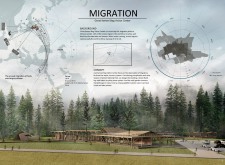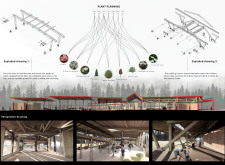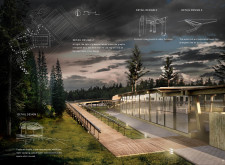5 key facts about this project
The architectural design emphasizes integration with the surrounding landscape, creating a harmonious relationship between built form and nature. The structure is divided into distinct areas including visitor information, ticketing, a café, and educational spaces, all geared towards promoting ecological awareness. It serves as a gateway to the Great Kemeri Bog, encouraging visitors to explore the diverse flora and fauna characteristic of this unique wetland environment.
Innovative Use of Natural Materials
This project’s unique approach lies in its material selection and incorporation of sustainable practices. The extensive use of pine wood for structural elements not only reflects local construction traditions but also enhances the thermal performance of the building. Glass is employed extensively to facilitate transparency, allowing visitors to connect visually with the external landscape. This design choice promotes an immersive experience, as interior spaces provide framed views of the bog and its wildlife.
Additionally, the building features a green roof system designed to collect rainwater and support local vegetation. This sustainable practice contributes to the environmental performance of the center, reducing runoff and fostering habitat for local species. The landscaping design incorporates native plant species, which minimizes maintenance needs and bolsters the ecological health of the area.
Integration with the Natural Landscape
The project’s design includes carefully planned outdoor spaces that enhance visitor engagement with the environment. A designated parking area allows for easy access while maintaining minimal visual impact. Camping sites and observation areas are included to encourage deeper interaction with the bog's ecosystem. Furthermore, a children’s playground incorporates natural play elements that educate young visitors about the local environment.
The visitor center also includes multifunctional spaces that cater to educational programs and community events. These spaces encourage collaboration and dialogue around conservation efforts, making the center a focal point for environmental education in the region.
For those interested in a detailed exploration of the Great Kemeri Bog Visitor Center, reviewing architectural plans, sections, and designs will provide deeper insights into the project’s thoughtful approach to combining functionality with ecological responsibility. Such examinations will reveal the underlying architectural ideas and how they manifest in both the structure and its integration with the surrounding landscape.


























